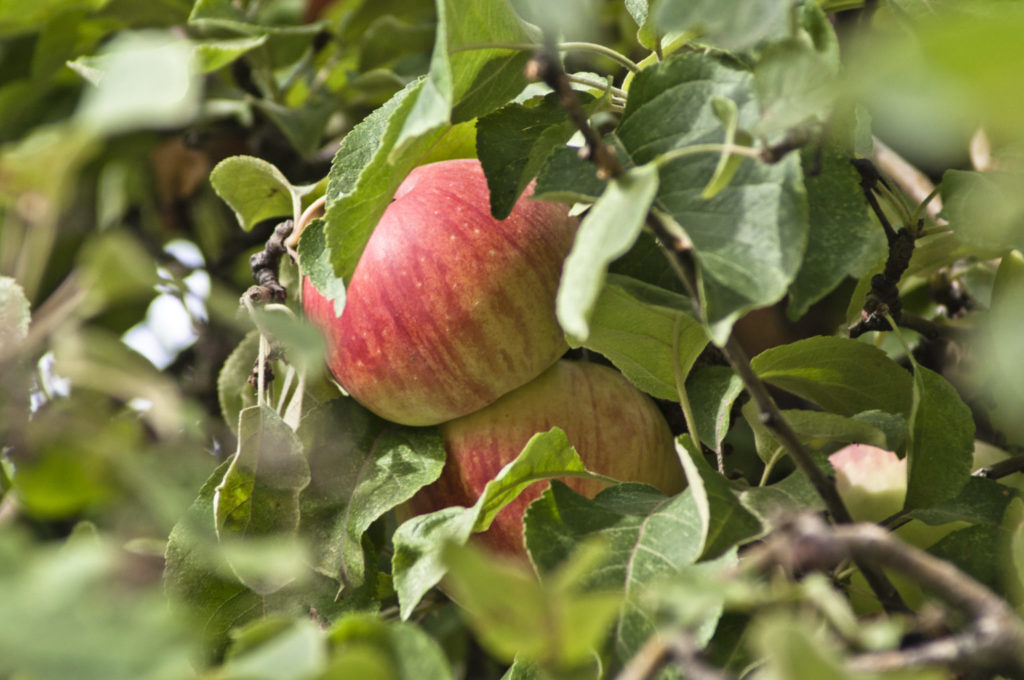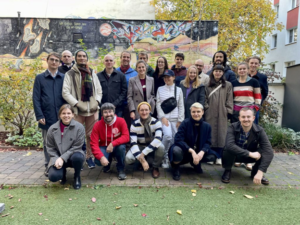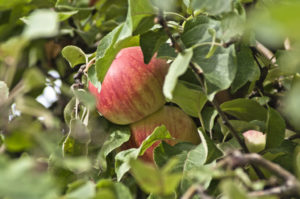CENTRAL ASIAN SCIENCE JOURNAL − Wild apple trees in Kazakhstan are said to have become increasingly “contaminated” by domestic apple trees, posing a threat to their survival. In parallel, research has determined the route of the Scythians, nomads originating from Mongolia.This article was originally published on Novastan’s French website on 26 April 2021. This scientific review will include: crossovers between Tian Shan apple trees and the risk that this poses to wild apple trees, a genome study on the Scythians, a group of nomadic steppe warriors from the 1st millennium BC, Kyrgyzstan’s mortality rate in recent decades and how identifying a potential habitat could better protect the Siberian Ibex.
The risk of crossover for wild apple trees
Malus sieversii is the ancestor from which all apple trees originate in the world. Native to the mountains of Central Asia, this wild apple tree is now found only in the Tian Shan mountain range. Classified as endangered by the International Union for Conservation of Nature (IUCN), crossovers with domestic apple trees, named Malus domestica, raise fears for the survival of this species. In an article published in the journal Genes on January 15, South Korean researchers studied the genetic diversity of eleven populations of wild and domestic apple trees located in the Kazakh section of Tian Shan. By focusing on thirteen genetic markers, they were able to map the genetic proximity of the 102 samples studied. Although this genetic diversity is quite similar to what has been observed in previous studies, the transfer of genes from cultivated apple trees to wild apple trees is greater than previously recorded. Researchers suggest that the spread of apple tree cultivation to areas where wild apple trees have historically grown is the reason behind the increasing crossovers.
The study also revealed facts about another wild species, Malus niedzwetzkyana, a tree which yields fruit with characteristically red flesh. Analyses reveal that the integrity of this endangered species may already have been compromised by crossovers with domestic apple trees in the few areas it can be found. In the future, the acceleration of hybridization coupled with the decline in the population of wild apple trees could lead to the disappearance of these species altogether. These trees are also an invaluable resource when it comes to genes used to improve crop varieties. Their preservation is therefore extremely important.
The Scythians, conquering the Iron Age steppes
The beginning of the 1st millennium BC is a pivotal moment in Central Asian history. At this time, a collection of peoples sharing similar mortuary rites, united under the term ‘Scythian’ cultures, changed the history of this region. At the beginning of the Iron Age, (-1100 − 400 AD) the Scythians transformed from sedentary people to nomadic warriors. Such a transition was enabled by new iron weapons and new riding techniques, such as the introduction of the saddle. An international study published on March 26 in Advanced Sciences focused on studying the genome of Scythian tombs in order to reconstruct the emergence and spread of this nomadic culture. The genomes of 111 individuals found in graves dating from 850 BC. J-C to 950 AD. J-C have been sequenced and compared to older genomes from several parts of Central Asia, as well as to the DNA of present-day Kazakhs. The analysis, carried out by researchers at the Max Planck Institute and the Almaty Institute of General Genetics and Cytology, revealed complex processes of population mixing. The origins of the spread of this nomadic culture can be found in the Kazakh steppes, where populations already present in the Bronze Age (2700 to 900 BC) mixed with peoples from a large region in the north of Mongolia and also with the peoples of southern Central Asia. As a result of this mixture, the Sarmatians and the East Scythians emerged in the Urals and Altai respectively, and subsequently spread across the Kazakh steppe from 800 to 100 BC. From the end of the Iron Age to 500 AD, the study reveals a continuous flow from eastern Eurasia to southern Kazakhstan and Persia. Finally, the comparison with the DNA of current Kazakhs shows that their genetic profile cannot solely be modelled from these ancient migrations. This suggests that the genetic homogeneity of the Kazakh ethnicity most certainly dates from the establishment of the Kazakh Khanate in the 15 century.
Trends in infant mortality in Kyrgyzstan
A study published last March and funded by Unicef in The Lancet Global Health looked at infant mortality in Kyrgyzstan from 1990 to 2018. Based on public data, researchers determined that infant mortality declined by 46% over this period. This reduction, compared to the 70% drop observed on average in the rest of Central Asia, varies by region. The analysis suggests that this decrease in mortality is mainly due to the increase in breastfeeding in the first hour after birth. The number of stillbirths remained constant, while deaths among children under five fell 69%, reflecting the trend observed in the rest of Central Asia. The black mark in Kyrgyzstan is the number of maternal deaths during childbirth, which has fallen by just 7%, compared to 54% in other Central Asian countries. The researchers also determined the main reasons for these deaths. Better management of premature births and the associated risks of infection and pneumonia could save nearly 4,000 newborns by 2030. Micronutrient supplementation for mothers would also greatly reduce their risk of death. With a set of other measures listed by the authors, around 600 lives could be saved each year in Kyrgyzstan by 2030.
Determining a potential habitat for the Capra Sibirica could help protect it
Finally, information has grown concerning the habitat of the Siberian ibex. Capra sibirica is a Central Asian ibex classified as “Near Threatened” by IUCN and very commonly found in Tian Shan. In order to better protect them, a study published in Scientific reports on March 16 attempted to determine a potential habitat for this species. By focusing on a small number of environmental factors, such as roughness of terrain, altitude, distance to a water source or type of vegetation, the researchers were able to define the main determinants for the site selection. This species has the particularity of seeing males and females choose different habitats during the summer season. Using the factors mentioned above, the scientists identified potential areas that meet their needs. Females seem to prefer rougher terrain which provides better safety for their cubs and is normally situated closer to a water source. Generally speaking, males prefer moderately uneven terrain at higher altitudes. This difference in altitude is believed to be due to the males’ increased sensitivity to heat. Higher altitude also allows them to avoid being bitten by certain insects that are present at lower altitudes. This work could be useful in choosing the areas that should be preserved in order to better protect the Siberian Ibex and its habitat.
Written by Anthony Vial
Translated from French by Alice Coveney
Edited by Maya Ivanova
For more news and analysis from Central Asia, follow us on Twitter, Facebook, Telegram, Linkedin or Instagram.
 Apple Trees, Scythians and Ibex: Research Summary in Central Asia
Apple Trees, Scythians and Ibex: Research Summary in Central Asia 



